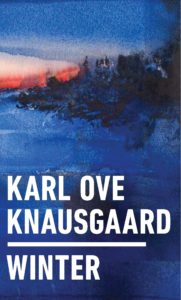Once I got into it — this winter, after failing last winter — this went by fast, and why not, it’s a collection of short autobiographical, ostensibly seasonal snippets from a Norwegian author who’s often mentioned as a potential Nobel laureate. As an object, the edition of Winter that I have is a lovely book: thick pages, pleasing margins and layout, gorgeous occasional watercolor illustrations by Lars Lerin. I think Ingvild Burkey’s translation from the Norwegian is good; there weren’t any places where I stumbled during reading, or where the phrasing caused me to wonder what the original was. Knausgaard writes simply and directly, at least in Winter, and Burkey renders that faithfully.
I liked the physicality of my copy of Winter, and I liked the concept: a book of short essays for each season, taking readers through a year, reflecting on changes and continuities, along with observations not necessarily prompted by the season. Winter takes in December, January and February, and is additionally framed by the expectation and then slightly premature birth of a daughter. The sections for each of the first two months begin with a “Letter to an Unborn Daughter” while February begins with a “Letter to a Newborn Daughter.” The baby turns out to be fine, by the way, and even the clubfoot that technicians thought they saw in ultrasound turned out to be a perfectly normal foot.
Some of the essays are quite good, especially when Knausgaard is observing the natural world, and winter’s effects on it. “Owls” and “Winter Sounds” from the December section, “Snow” and “Winter” from January, along with “Fish,” “Winter Boots” and “Snowdrifts” from February are all evocative and effective. They’re what I had hoped all of Winter would be like. Here is a bit from “Winter Boots” when he writes about what makes something memorable:
When it comes to winter boots, a pair that I remember well is typically one that I didn’t get. They were so-called Sami boots, tall, snug-fitting around the calves, of light-coloured leather, with upturned toes. Why I wanted them so badly I have no idea, but I did, I have a memory of standing in front of the display window of the shoe shop in Arental staring at the fabled boots. It may have been due to a TV series that was shown around that time, about a Sami boy called Ante, which had a big influence on me and everyone I knew. My mother knitted me a sweater that I thought of as Sami-like, it had split sides so that the front and back panels flapped loosely … Once when I was running down the hill towards the house wearing the sweater, I remember having a distinct “Sami feelin”, I was like a Sami or an American Indian, and the feeling filled me with jubilation. That instant, which can’t have lasted more than a few seconds, is one of my strongest childhood memories. The wind in my face, the loincloth-like flaps slapping against my thighs and bum as I ran, the gravel crunching under my feet, the fog hanging between the trees on the other side of the road. I suppose it was that feeling I wanted to have again as I stood staring at the tall light-coloured boots in the shop window. (pp. 199–200)
His brief portraits of people he knows are also some of the stronger pieces in the book. There’s Thomas, the photographer, capturer of moments who is really interested in timelessness. “[H]e stands in the light and photographs the shadow he casts.” (p. 137) Or Georg, one of those “writers you can’t understand until you’ve met them. … He had the most sensitive eyes I have seen. They were filled with sorrow, and they took everything in.” (p. 141)
Unfortunately, I found that significant parts of Winter fall far short of these highlights, sometimes in the same essay. In “Winter Boots,” for example, just before his meditation on longing for Sami boots, he writes that “boots belong to the zeitgeist, that invisible nexus which links all people and inspires them to design objects that resemble each other.” (p. 199) With due respect to Hegel, had Knausgaard really lived more than forty years without encountering the concept of marketing? There are reasons for fashions in consumer goods like boots, and they are as visible as bottom lines and annual financial reports. An banal piece on sexual desire veers off into science fiction that a 1930s pulp editor would have been embarrassed to publish. Knausgaard asks what a society without sexual desire, with reproduction by artificial insemination, would be like and posits that “The two sexes would become more and more similar, eventually merging into one. This single-sexed organism, devoid of desire for any of its fellow creatures, would still have all of its other human emotions intact … It would be a society without war, without violence, and thus a society in which utopian goodness and security were realised.” (pp. 132–33) I hardly know where to begin with those notions, except maybe to wonder whether Knausgaard has anyone who will talk sense with him.
I finished the book with an impression of Knausgaard as an all too typical type, a middle-aged white guy aggrieved by people who tell him, for example, that consuming mass quantities of sugar is not good for him, and that the gas guzzlers of the 1970s are no way to design cars nearly half a century later. He thinks he’s profound and insightful, and occasionally he is, but not nearly as often as he seems to believe. Maybe he thinks it’s brave to show so many of his shortcomings on the page, but it strikes me as just another example of unpleasant self-involvement. At any rate, Winter has taken Knausgaard’s six-book autobiographical series of novels off my t-b-r list, and I am glad for that service.

